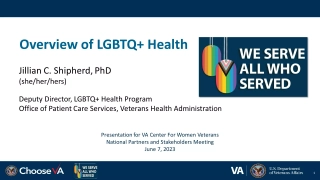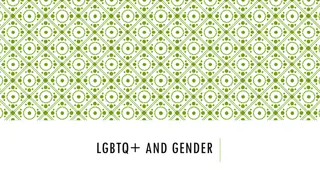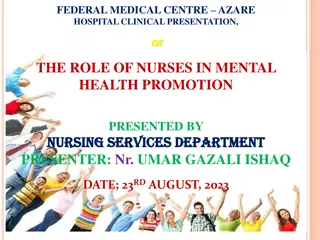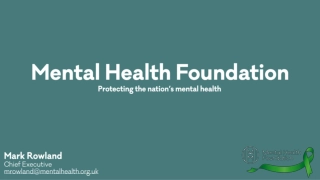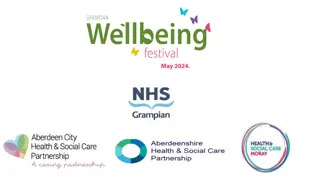Affirming Mental Healthcare for LGBTQ+/POC: Understanding the Importance of Client Identities
This presentation delves into the significance of acknowledging client identities in mental healthcare for LGBTQ+ and POC individuals. It covers terminology related to gender identity, sexual orientation, and gender affirmation, emphasizing the importance of respecting diverse identities and experiences in healthcare settings.
Download Presentation
Please find below an Image/Link to download the presentation.
The content on the website is provided AS IS for your information and personal use only. It may not be sold, licensed, or shared on other websites without obtaining consent from the author. Download presentation by click this link. If you encounter any issues during the download, it is possible that the publisher has removed the file from their server.
Presentation Transcript
Affirming Mental Healthcare for LGBTQ+/POC: Understanding the Importance of Client Identities Acknowledgements: Content in this presentation was provided in part by Dr. Adam Gonzalez, Dr. Allison Eliscu, and Rose Cardin
G A Y Q* U E E R L E S B I A N B I S E X U A L T R A N S G E N D E R Sexual Orientation & Gender Identity Sexual Orientation Gender Identity
Terminology Sex assigned at birth or Birth Sex- male/female/ intersex based on reproductive organs and genitalia at birth. Gender identity- one s own feeling, internal sense of being man, woman or in-between. Can change over time Gender expression- external manifestations of gender person s name, pronouns, clothing, haircut, etc. Gender expression Gender identity Sex Gender 3
Terminology Transgender- Individuals whose gender identity and/or gender expression differs from what is typically associated with the sex they were assigned at birth. Female to male (Transgender Male/Trans Man) -Female at birth, identify as male Male to female (Transgender Female/Trans Woman) -Male at birth, identify as female Non-binary individual whose gender identity isn t exclusively male or female Gender queer Cis-gender a term for people whose gender identity matches the sex they were assigned at birth. 4
Terminology Gender Affirmation-The act of changing one s gender expression to match their gender identity Changing hairstyle or clothing Changing name and pronoun use Changing name/gender on legal documents Masculinizing and Feminizing Hormones Gender confirmation surgery (avoid the term sex change) 5
Terminology Sexual Orientation: refers to physical, romantic and/or emotional attraction o Gay- Describes a person attracted to someone of the same gender o Lesbian- Describes a woman attracted to other women o Heterosexual- Describes a person attracted to someone of a different gender Avoid using the term sexual preference ; homosexual 6
Terminology Sexual Orientation: refers to physical, romantic and/or emotional attraction o Bisexual (bi)- Describes a person attracted to people of multiple genders; attracted to men and women. Asexual- Describes an individual who does not experience sexual attraction Queer- Used by some to describe an individual whose sexual orientation is not exclusively heterosexual; also used to describe gender identity o o Coming Out: Lifelong process of self-acceptance and disclosure of one s identity to others. Varying degrees of outness. Do Not Assume that Sexual orientation/attraction = Behaviors 7
Case Tim You are a provider in a psych ER and your next patient has just arrived. The nurse tells you, This young man has been brought in by his mother for engaging in self-harming behaviors and worsening depression . In the room, the patient introduces themselves as Tim. You open the electronic medical record and the chart says the name Tiffany . You say, Oh, I think we opened the wrong chart, do you have a sister named Tiffany? The patient turns red, looks at the ground, and says, Uh, no that s me, but I go by Tim and I m non-binary.
Case - Discussion What was your reaction when the patient said his name was Tim and disclosed identity as non-binary? How do you think Tim felt at that moment? Understand and confront personal biases Provider discomfort can interfere with providing good medical care It is an ethical obligation to treat all patients respectfully
Case - Discussion How do you ask a patient about their gender when you are confused? Tim What name do you use? He/him What pronouns do you use? Male How do you identify your gender? Do Not Assume Be Supportive 14
Case Tim Based on your assessment, you determine that Tim is at elevated risk for suicide given past attempts, current ideation, plan and intent. Tim will need an admission. How do you refer to this patient when documenting in the EHR? assigned at birth). They are presenting with worsening depression and suicide ideation with a plan and intent. Tim is 16 years old and identifies as non-binary (female sex
Case - Discussion A nearby facility is called to check if they have a bed. The facility has bed availability (YES!) and gender segregated units. o How do you handle the conversation with the facility and with Tim? o What are some important considerations? o Tim s preferences? Safety concerns?
Avoid Assumptions Do NOT assume: Patients are heterosexual Orientation/Attraction equals behavior Sexual orientation based on gender of partner LGBTQ+ patients are engaging in risky behavior LGBTQ+ patients have unsupportive families Sexual orientation or gender identity based on appearance All transgender individuals want to undergo surgery
Ask the Right Questions What is your current gender identity? Man Woman Transgender man Transgender woman Gender queer Nonbinary, gender fluid What was your sex assigned at birth? Male Female Intersex


